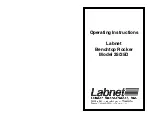
Glossary
101
RNS
®
System User Manual
G
LOSSARY
Adaptive%.
Adaptive% is an advanced responsive therapy setting. The Adaptive% specifies a ratio of the
pulse-to-pulse interval of the stimulation to the sensed signal period.
Adapt channel.
The adapt channel is an advanced responsive therapy setting. The neurostimulator will
monitor this channel from which to calculate the adaptive stimulation frequency. This channel is used for
all adaptive bursts.
Adaptive Default Frequency.
The adaptive default frequency is an advanced setting available for each
responsive therapy burst. For an adaptive therapy burst (Adaptive Frequency = ON), if the calculated
stimulation frequency does not fall between the programmed min and max frequencies, then the
stimulation is delivered at the adaptive default frequency.
Adaptive Max Frequency.
The adaptive max frequency is an advanced setting available for each
responsive therapy burst. For an adaptive therapy burst (Adaptive Frequency = ON), the adaptive max
frequency specifies the maximum stimulation frequency. If the calculated stimulation frequency does not
fall between the programmed min and max frequencies, then the stimulation is delivered at the adaptive
default frequency.
Adaptive Min Frequency.
The adaptive min frequency is an advanced setting available for each
responsive therapy burst. For an adaptive therapy burst (Adaptive Frequency = ON), the adaptive min
frequency specifies the minimum stimulation frequency. If the calculated stimulation frequency does not
fall between the programmed min and max frequencies, then the stimulation is delivered at the adaptive
default frequency.
Amplifier gain.
ECoG signal amplification on one channel of the neurostimulator.
Amplifier input.
Amplifier inputs are the two electrode-sensing inputs to process and generate one
amplified and filtered ECoG signal in the neurostimulator.
Annotation.
Annotations are placed by the user on a stored ECoG record to mark the type of activity
present.
Anode.
The positive pole of an electrode selected for stimulation.
Area detection tool.
The area detection tool measures the area under the curve of an ECoG signal.
Asynchronous pulse.
Delivery of the first pulse in a burst independent of the ECoG activity.
Bandpass detection tool.
The bandpass detection tool measures the approximate frequency of the
signal based on the duration and amplitude of waveform segments.
Battery Life Optimization Procedure.
The programmer delivers brief bursts of the selected therapy in
order to determine the optimal neurostimulator settings for maximizing battery life. If this procedure is
skipped, the neurostimulator will be programmed with default settings.
Battery measurement.
The neurostimulator battery voltage may be measured interactively through the
programmer.
Burr hole
.
Hole made in the skull used for the insertion and security of implanted cortical and/or depth
leads.
Burr hole cap.
The burr hole cap is intended to secure the leads in relation to the cranium.
Burr hole cover.
The burr hole cover is intended to secure the leads to the burr hole cap.
Burst.
An individually programmed group of one to many pulse(s) of current delivered by the
neurostimulator.
Burst duration.
The amount of time during which a burst will be delivered by the neurostimulator.










































